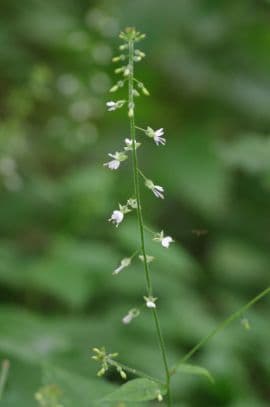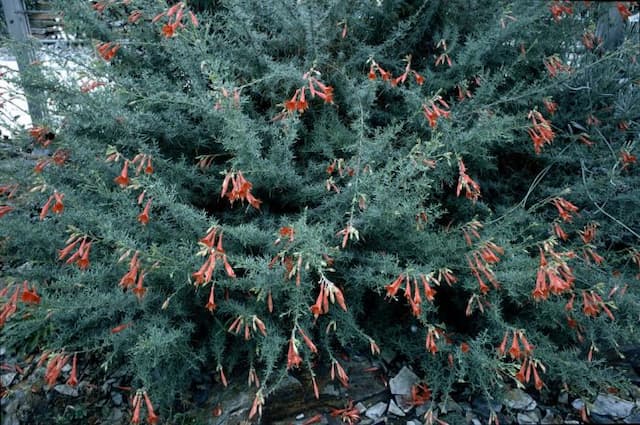Fuchsia Fuchsia 'Genii'

ABOUT
Fuchsia 'Genii' is a striking ornamental plant known for its vibrant and distinctive flowers, along with its attractive foliage. The flowers are particularly eye-catching, with a two-toned appearance, comprising a vivid array of purples and pinks. They have a unique pendant shape, sometimes described as teardrop or lantern-like, hanging elegantly from the stems. The petals are long, and slender and often display a deep pink to purple hue, while the sepals—the part of the flower that encases the bud—can be a contrasting lighter pink or even a blush of white. Adding to its charm, 'Genii' has golden-yellow to lime green leaves, which are somewhat elongated and pointed at the tips. They provide a beautiful backdrop for the flowers and can brighten up the plant's overall appearance. The foliage is somewhat bushy, creating a dense and leafy habit. 'Genii' typically blooms from late spring to early fall, offering a long season of visual interest. Its flowers attract hummingbirds and butterflies, making it not only a garden favorite for its looks but also for its ability to support local wildlife. Overall, with its extraordinary flowers and luminous foliage, Fuchsia 'Genii' is a delightful addition to any garden where it can be showcased in hanging baskets, containers, or borders for a brilliant burst of color.
About this plant
 Names
NamesSynonyms
Golden Fuchsia, Genii Fuchsia
Common names
Fuchsia 'Genii'.
 Toxicity
ToxicityTo humans
Fuchsia is generally considered non-toxic to humans. There are no significant toxic effects expected from the accidental ingestion of small quantities of Fuchsia parts. However, eating non-food plants can potentially cause gastrointestinal discomfort due to the fibers and compounds they contain that are not meant for human digestion. If large amounts are consumed, it may result in more pronounced symptoms such as nausea, vomiting, or diarrhea. Always exercise caution and prevent children from eating ornamental plants.
To pets
Fuchsia is generally considered non-toxic to pets as well. Similar to humans, ingestion of Fuchsia by pets is not expected to cause significant toxic effects. Nonetheless, ingestion of plant material can cause mild gastrointestinal upset in some animals, which might present as vomiting or diarrhea. If you suspect your pet has ingested a large amount of the plant and is showing signs of distress, it is advisable to consult a veterinarian. As with any non-food plant, it’s best to keep it out of reach of curious pets.
 Characteristics
CharacteristicsLife cycle
Perennials
Foliage type
Deciduous
Color of leaves
Green
Flower color
Mixed
Height
1-2 feet (0.3-0.6 meters)
Spread
1-2 feet (0.3-0.6 meters)
Plant type
Shrub
Hardiness zones
9
Native area
Central America
Benefits
 General Benefits
General Benefits- Ornamental Value: Fuchsia 'Genii' is highly valued for its attractive foliage and vibrant, hanging flowers which add a splash of color to gardens.
- Attracts Pollinators: The plant produces nectar-rich flowers that attract hummingbirds, butterflies, and other beneficial insects.
- Shade Tolerance: This variety of fuchsia performs well in partial shade, making it ideal for adding interest to shaded areas of the garden.
- Versatility: Fuchsia 'Genii' can be grown in containers, hanging baskets, or borders, offering a flexible choice for different garden designs.
- Long Flowering Period: It blooms from late spring to early fall, providing a long season of visual interest.
- Easy to Propagate: The plant can be easily propagated by cuttings, allowing gardeners to create new plants for free.
- Resilience to Pests: While not immune, fuchsias are relatively resistant to pests, reducing the need for chemical interventions.
- Easy Pruning: Fuchsia 'Genii' responds well to pruning, which helps to maintain its shape and encourage more prolific blooming.
- Perennial Growth: As a perennial, it can return each year in suitable climates, reducing the need to replant annually.
 Medical Properties
Medical PropertiesThis plant is not used for medical purposes.
 Air-purifying Qualities
Air-purifying QualitiesThis plant is not specifically known for air purifying qualities.
 Other Uses
Other Uses- Fuchsia 'Genii' plants can be used to create a visually striking focal point in a mixed border thanks to their vibrant foliage and contrasting flower colors.
- Their cascading growth habit makes them ideal for hanging baskets, adding a vertical element of interest in small gardens or balconies.
- Their unique blossoms can be used as natural art in floral photography, providing a stunning subject with their vivid colors and shapes.
- Fuchsias can be trained as bonsai, offering a challenging and rewarding project for enthusiasts who enjoy sculpting plants into miniature trees.
- Their flowers can be used to add an exotic flair to summer desserts when crystallized or as edible garnishes, as long as they haven’t been treated with pesticides.
- Because of their bright colors, Fuchsia 'Genii' can be planted to attract and support pollinators, like bees and hummingbirds, which are essential for a healthy ecosystem.
- The shrub can be planted as a natural fence or privacy screen in gardens, providing both aesthetic appeal and functionality.
- They can also be used in sensory gardens for their textured foliage and the soft, bell-like texture of their flowers, which provide a tactile experience.
- Children can be taught about plant growth and care by using Fuchsia 'Genii' as an educational tool in schools or home gardens.
- For those interested in craft, the distinctive flowers and foliage can be used as inspiration for textile patterns, such as embroidery or fabric prints.
Interesting Facts
 Feng Shui
Feng ShuiThe Fuchsia is not used in Feng Shui practice.
 Zodiac Sign Compitability
Zodiac Sign CompitabilityThe Fuchsia is not used in astrology practice.
 Plant Symbolism
Plant Symbolism- Elegance - Fuchsia 'Genii' carries an air of sophistication due to its delicate, pendulous flowers and gracefulness in form.
- Good taste - The vibrant colors and aesthetic appeal of the flowers represent a sense of good taste and refinement.
- Confiding love - Historically, the fuchsia flower has been associated with confiding love, perhaps because of its intimate, hanging blooms that seem to whisper closely.
- Ambiguity or duality - With its two-tone flowers often displaying a combination of purple and pink hues, the fuchsia plant can symbolize the complexity or duality of emotions in relationships.
 Water
WaterFuchsia 'Genii', commonly known as Hardy Fuchsia, prefers consistent moisture without being waterlogged. During the growing season, spring through summer, water regularly to maintain evenly moist soil; this may be approximately once or twice a week, but always check the soil moisture before watering. Aim for giving the plant about 1 to 2 gallons of water each time, depending on the size of the plant and the environmental conditions. During the winter, reduce watering significantly, allowing the top inch of soil to dry out between waterings. Ensure good drainage to prevent root rot, which can occur if the soil remains too wet for too long.
 Light
LightHardy Fuchsia thrives in partial shade to filtered light conditions. It's best to position the plant in a spot where it receives morning sunlight and afternoon shade or dappled sunlight throughout the day. Avoid exposing it to the intense midday sun, as this can scorch the delicate leaves and flowers.
 Temperature
TemperatureHardy Fuchsia performs best in temperatures ranging from 60 to 75 degrees Fahrenheit. It can tolerate a minimum temperature down to about 40 degrees Fahrenheit but should be protected from frost. Avoid placing the plant in areas where temperature fluctuations are common or where it could be exposed to freezing conditions.
 Pruning
PruningPruning Hardy Fuchsia is essential to maintain its shape, encourage bushier growth, and promote more prolific blooming. It's best to prune in late winter or early spring before new growth begins. Remove dead or damaged branches and trim back by one-third to one-half of the previous year's growth. Regularly deadheading spent flowers during the blooming season will also stimulate new blooms.
 Cleaning
CleaningAs needed
 Soil
SoilFuchsia 'Genii', commonly known as Fuchsia, thrives best in a well-draining, fertile potting mix with a pH between 6.0 and 7.0. A good soil recipe for Fuchsia includes one part peat or coco coir, one part perlite or vermiculite, and one part loam or garden soil. This mixture ensures adequate drainage, air space, and nutrient retention to support the plant's growth.
 Repotting
RepottingFuchsias, like the Fuchsia 'Genii', should generally be repotted every year or two, preferably in the spring as they come out of dormancy. If the plant shows signs of being root-bound or if the soil is exhausted, it's time to repot into a slightly larger container with fresh potting soil.
 Humidity & Misting
Humidity & MistingFuchsia 'Genii' does best in moderate to high humidity conditions, ideally between 55% and 75%. Maintaining these humidity levels will support the plant's growth and flower production while too low humidity may cause stress.
 Suitable locations
Suitable locationsIndoor
Keep Fuchsia 'Genii' in bright, indirect light. Ensure high humidity and cool temps.
Outdoor
Plant Fuchsia 'Genii' in partial shade. Protect from frost and excess heat.
Hardiness zone
9-11 USDA
 Life cycle
Life cycleThe Fuchsia 'Genii', commonly known as Genii fuchsia, begins its life cycle with seed germination, occurring in warm, moist soil conditions, usually in the spring. Once germinated, the plant enters a phase of vegetative growth, developing distinctive foliage that is a bright golden-green color and pendant, tubular flowers that attract hummingbirds and pollinators. The flowering stage can last throughout the summer, with regular deadheading encouraging continued blooms. After flowering, the plant may produce small, dark berries which contain seeds, completing the reproductive cycle. In areas with mild winters, the Genii fuchsia can behave as a perennial, surviving the cold months and resuming growth in the spring; in harsher climates, it is often treated as an annual or must be overwintered indoors. Pruning in late winter or early spring can promote bushier growth and enhance flowering in the following season.
 Propogation
PropogationPropogation time
Spring-Early Summer
The Fuchsia 'Genii', also known as Hardy Fuchsia, is typically propagated through softwood cuttings. The best time to propagate these plants is in the spring to early summer when they are actively growing. Cuttings should be about 4 inches (approx. 10 cm) in length and taken just above a leaf node. Leaves on the lower half of the cutting should be removed, and the base of the cutting can be dipped in rooting hormone powder to encourage root growth. The cutting is then planted in a moist potting mix, with the bottom half buried in the soil. The pot should be placed in a warm, well-lit area but out of direct sunlight to avoid drying out. A plastic bag or propagator can be used to cover the pot and maintain humidity around the cutting which helps improve the chances of successful rooting.









